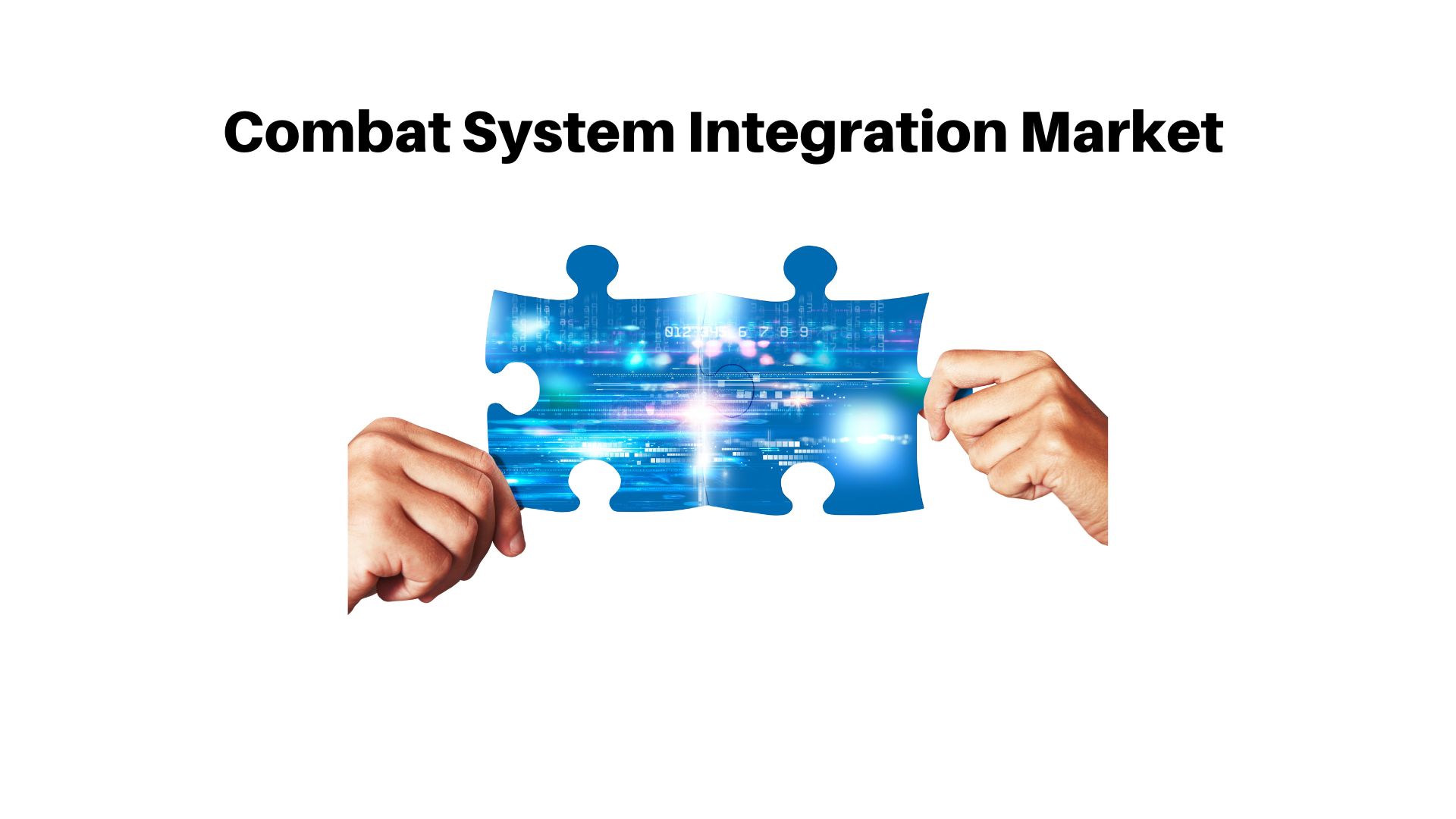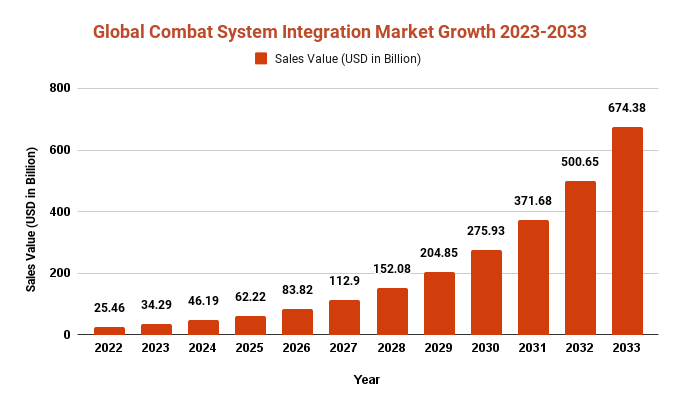Combat System Integration Market Expected to Expand at a Growing CAGR of 34.7% through 2033

Page Contents
Market Overview
Published Via 11Press: Combat system integration Market refers to the practice of unifying different subsystems and components of a combat system into an effective whole capable of detecting, tracking, and engaging targets. CSI is an essential aspect of modern military operations as it facilitates effective use of weapons and sensors while improving situational awareness among military personnel. Combat systems consist of components like sensors (radar, sonar and electro-optical), weapon systems such as missiles, guns and torpedoes as well as command and control systems (CCI). When integrated together effectively into one single system they can effectively detect targets, select weapons accordingly and engage targets more effectively than ever.
The Combat System Integration Market size is expected to reach USD 674.38 Bn by 2033, up from its current value of USD 25.46 Bn in 2022, growing at an annual compound growth rate (CAGR) of 34.7% from 2023-2033.
Integration processes involve several key steps, including system design, integration testing and system validation. System design involves defining requirements for the system and creating a detailed design that meets them; integration testing includes verifying that all subsystems and components work as intended, while system validation involves testing it against real world conditions to make sure it fulfills operational needs and expectations. CSI can be a daunting and time-consuming process, involving integration of numerous technologies as well as collaboration among different stakeholders such as engineers, military personnel and procurement officials. Yet effective CSI remains critical to modern military operations' success: it enables forces to detect, track and engage targets efficiently while operating with maximum situational awareness and effectiveness.
Key Takeaways
- Combat system integration involves joining together different subsystems and components into an effective whole that can detect, track and engage targets effectively.
- Combat systems include sensors, weapon systems and command and control systems as its constituent elements.
- CSI encompasses multiple critical steps, including system design, integration testing and system validation.
- Effective CSI is central to modern military operations, as it allows forces to detect, track, and engage targets more easily while operating with maximum situational awareness and effectiveness.
- CSI is an intricate process, which necessitates integrating various technologies as well as close cooperation among engineers, military personnel, and procurement officials.
- Combat systems integration is ever-evolving as new technologies emerge, making it essential for military forces to remain abreast of recent advancements to maintain operational advantage and remain effective.

Regional Snapshot
- North America: Both the U.S. and Canada possess highly integrated combat systems that combine advanced sensors, weapons, command and control systems as well as command and communication systems to provide highly effective defenses against air, surface, and subsurface threats. One such example is the Aegis Combat System of the U.S. Navy which integrates radar, weapons control functions and command and control functions to provide highly effective air defense protection from threats such as flying insects or missile threats.
- Europe: European military forces such as those of the UK, France and Germany possess highly integrated combat systems with advanced sensors and weapons incorporated. For instance, UK's Type 45 destroyer features the Sea Viper air defense system, which integrates radar, weapons control and command and control functions for highly effective air defense capabilities.
- Asia-Pacific: Countries in the Asia-Pacific region such as China, Japan and South Korea possess militaries with highly integrated combat systems that use advanced sensors and weapons systems. For instance, China's Type 052D destroyer includes an Aegis-like S-band radar system to provide air and missile defense capabilities that are extremely effective.
- Middle East: Military forces from Israel and Saudi Arabia possess highly integrated combat systems with advanced sensors and weapons systems, such as Israel's Iron Dome air defense system incorporating radar, weapon control and command and control functions for enhanced air and missile defense capabilities.
Any inquiry, Speak to our expert at: https://marketresearch.biz/report/combat-system-integration-market/#inquiry
Drivers
- Mission effectiveness: Combat system integration's primary goal is to maximize mission effectiveness. By integrating sensors, weapons, and command and control systems into military forces' arsenals, forces can more quickly detect, track and engage their targets more accurately with greater speed, precision and lethality.
- Situational Awareness: Integrating combat systems enhances situational awareness on the battlefield, which is essential for effective decision-making and combat management. Military forces using integrated combat systems are better equipped to quickly recognize threats, evaluate situations accurately, and respond with appropriate responses.
- Multi-Domain Operations: Military forces are increasingly engaging in multi-domain operations that span multiple domains – air, land, sea and cyber capabilities must all work in unison for effective execution of multi-domain missions. Integrative combat systems enable military forces to coordinate across these various realms more seamlessly for maximum coordination and effectiveness.
- Technological Progress: Technological advancements have made combat system integration increasingly feasible and effective, leading military forces to invest in cutting-edge technologies to boost combat capabilities and remain competitive.
- Cost Efficiency: Combat system integration can significantly enhance cost efficiency by eliminating duplicate systems and making more efficient use of existing resources. By integrating different systems together, military forces can decrease personnel requirements to operate and maintain these systems as well as associated costs of procurement and maintenance.
Restraints
- Complexity: Integrating combat systems can be an intricate and time-consuming process that necessitates combining various technologies and components together, which may result in delays, cost overruns, and technical challenges.
- Interoperability: Combat system integration may be limited by interoperability issues between different systems. Military forces may use various systems and standards that present hurdles when trying to integrate systems across organizations and countries.
- Combat system integration: It may also be restricted by security concerns, particularly when integrating systems from various suppliers and countries. Ensuring the integrity of integrated systems is vital in order to protect critical military information against unauthorised access and ensure its protection.
- Training and Personnel: Integrating combat system requires personnel with the required expertise, education, and training to operate and maintain integrated systems effectively. However, accessing sufficient trained personnel may prove to be an obstacle, particularly in smaller military forces.
- Cost: Combat system integration can be costly, particularly when dealing with advanced or complex systems. Budget constraints often prevent smaller military forces from undertaking combat system installations on an adequate scale.
Opportunities
- Enhance mission effectiveness: Combat system integration can boost mission effectiveness by improving situational awareness, increasing precision and lethality, facilitating more coordinated responses to threats, and providing more coordinated responses from authorities.
- Increased Interoperability: Combat system integration can enhance interoperability among different military forces and countries by integrating different systems and standards into one cohesive unit, leading to more successful joint operations and coalition warfare operations.
- Combat system integration: It can leverage technological advancements to bolster combat capabilities. Artificial intelligence, machine learning and automation integrations may improve decision making speed and accuracy as well as response speed.
- Multi-Domain Operations: Combat system integration can facilitate multi-domain operations, allowing military forces to coordinate more efficiently across air, land, sea, space, and cyberspace environments.
- Combat system integration can reduce costs by eliminating duplicate systems, optimizing existing resources more effectively, and decreasing personnel requirements to operate and maintain those systems.
Challenges
- Complexity: Combat system integration can be an intricate and challenging process that involves the coordination of diverse technologies and components. Integrating disparate systems may result in delays, cost overruns, or technical hurdles that must be surmounted to meet deadlines.
- Interoperability: Combat system integration can be hindered by interoperability issues between different systems. Different military forces may utilize differing platforms and standards, which create difficulties when trying to integrate systems across organizations and countries.
- Security: Combat system integration can also be hindered by security concerns, especially when combining systems from various suppliers and countries. Ensuring the integrity of integrated systems is essential in order to prevent unauthorised access and protect military-critical information.
- Training and Personnel: Integrating combat systems requires personnel with the knowledge and training to operate and maintain integrated systems effectively, but finding qualified personnel for smaller military forces may prove to be challenging.
- Cost: Integrating combat systems can be costly, particularly when working with advanced and complex systems. Budget limitations often restrict small military forces in their pursuit of integration of combat systems.
- Legacy systems: Many military forces still rely on legacy systems that are difficult to integrate with modern combat systems, making upgrades and integration efforts a considerable challenge. When these legacy systems are integral parts of daily operations, upgrading or integrating can become especially daunting.
Market Segmentation
Application
- Naval
- Airborne
- Land-Based
platform
- Large Combat Ships
- Medium Combat Ships
- Small Combat Ships
- Submarines
- Fighter Aircraft
- Helicopters
- Armored Vehicles
Key Players
- ICI Services Corporation
- Lockheed Martin Corporation
- Leonardo-Finmeccanica
- Raytheon Company
- Thales Group
- Elbit Systems Ltd
- DCS Corporation
- Qinetiq Group
- Saab AB
- BAE Systems amongst others
Report Scope
| Report Attribute | Details |
| Market size value in 2022 | USD 25.46 Bn |
| Revenue forecast by 2033 | USD 674.38 Bn |
| Growth Rate | CAGR Of 34.7% |
| Regions Covered | North America, Europe, Asia Pacific, Latin America, and Middle East & Africa, and Rest of the World |
| Historical Years | 2017-2022 |
| Base Year | 2022 |
| Estimated Year | 2023 |
| Short-Term Projection Year | 2028 |
| Long-Term Projected Year | 2033 |
Recent Developments
- Digitalization: Combat system integration has seen a trend toward digitization, which incorporates advanced technologies like artificial intelligence, machine learning and automation to boost combat capabilities.
- Cybersecurity: With system integration gaining increased attention, cybersecurity has been receiving an increased priority in terms of technologies and standards to protect integrated systems from potential cyber threats.
- Interoperability: Work to increase interoperability among various military forces and countries continues, including developing common standards and systems to facilitate more effective joint operations and coalition warfare.
- Multi-Domain Operations: There has been an increased focus on multi-domain operations, which involve the combination of different military domains (air, land, sea, space and cyberspace) to allow more coordinated and effective responses to threats.
- Commercial Off the Shelf (COTS) Technology: Commercial off the Shelf (COTS) technology has become an integral component of combat system integration, using available commercial products and technologies from vendors off-the-shelf to reduce costs while expanding capabilities.
- Modular open System Architecture (MOSA): MOSA has seen increasing adoption for use in combat system integration, using open standards and architectures to integrate disparate components together seamlessly.
Key Questions
Q: What is Combat System Integration (CSI)?
A: Combat system integration refers to the practice of combining various military systems and technologies in order to increase mission effectiveness and combat capabilities.
Q: What are the Benefits of Combat System Integration?
A: Combat system integration provides many advantages, such as increased mission effectiveness, interoperability enhancements, technological advances, support for multi-domain operations and cost efficiency.
Q: What are the challenges associated with combat system integration?
A: Combat system integration presents various obstacles, including complexity, interoperability, security concerns, training of personnel needed for its deployment and costs associated with legacy systems.
Q: What have been recent developments in combat system integration?
A: Recent advancements include digitalization, cybersecurity, interoperability, multi-domain operations, COTS technology and MOSA.
Q: Why is Combat System Integration So Important?
A: Combat system integration is crucial because it enhances combat capabilities, increases situational awareness, provides for coordinated responses to threats, supports joint operations and coalition warfare operations and boosts cost efficiency. Integrated platforms also take advantage of advancements in technology while improving cost efficiency.
Contact us
Contact Person: Mr. Lawrence John
Marketresearch.Biz (Powered By Prudour Pvt. Ltd.)
Tel: +1 (347) 796-4335
Send Email: [email protected]
The team behind market.us, marketresearch.biz, market.biz and more. Our purpose is to keep our customers ahead of the game with regard to the markets. They may fluctuate up or down, but we will help you to stay ahead of the curve in these market fluctuations. Our consistent growth and ability to deliver in-depth analyses and market insight has engaged genuine market players. They have faith in us to offer the data and information they require to make balanced and decisive marketing decisions.



